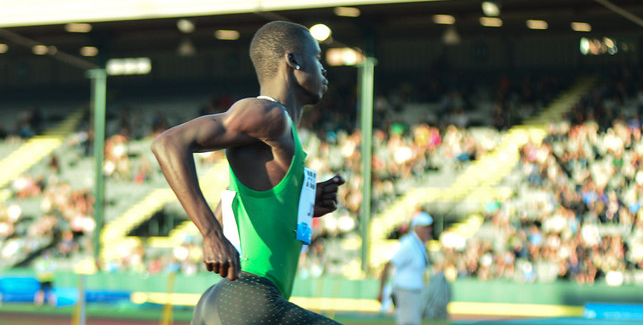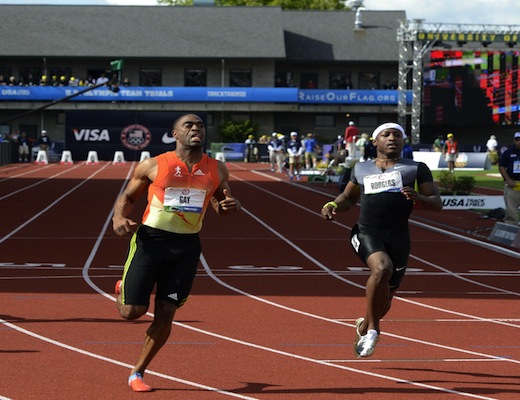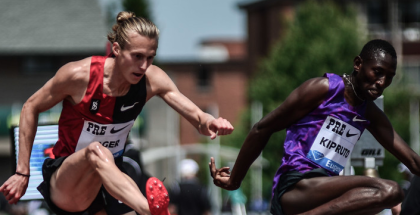A-Z Guide to the US Championships Part 2
Kevin Sully | On 23, Jun 2015
If you missed Part 1 of the preview, (letters A-M), click here. For a deeper preview on the women’s steeplechase field, check out this story on Emma Coburn, Ashley Higginson and the rest of the contenders. And now, N-Z…….
New Names
We saw it last year with Tori Bowie–an undiscovered talent gets a lane in a Diamond League meet and immediately vaults herself into the top tier of sprinters in the world. In terms of professional sports, track has very few barriers of entry.
You run the time, you can get into the meet. You do well in that race, you can run in even bigger meets. And so on. That’s how Bowie went from Pre Classic lane filler to Diamond League mainstay in 2014.
An even more improbable story is happening this year with Boris Berian in the men’s 800. He dropped out of college and was working at McDonald’s before he began running with the Big Bear Track Club. In his first year with the group, he lowered his personal best from 1:48 to 1:43.84. Because of track’s meritocracy it didn’t take long before he was racing the best runners in the world. He finished less than .3 behind David Rudisha in New York–a result that should give him confidence because nobody he will race this weekend is anywhere near David Rudisha.
Off-events
The folks who have byes still have to make an appearance at the meet. Ashton Eaton won’t do the decathlon and instead will hop in the headline-rich men’s long jump. That event features medalists Christian Taylor and Will Claye, double NCAA champion Marquis Dendy and NFL wide receiver (and 2012 Olympic long jumper) Marquise Goodwin.
Off-events are a chance for folks who are really good at one event to show that they are also really good at other events. Eaton is a perfect example. He is seeded eighth, but I’m sure he outperforms the projections and makes the pure jumpers very nervous for a few rounds.
Parity
Because of Berian, the men’s 800 has the highest potential of producing a top three you never would have predicted at the beginning of the season. Nick Symmonds and Duane Solomon have dominated the event in this country. Together they have won the last seven US titles and have been the main American presence at Diamond League meets and global championships.
This year, there has been a significant weakening in their hold on the 800. Symmonds’s 2015 best is only 1:46.37 and Solomon’s highlight for the year thus far is a 1:47 4 x 800 split at the World Relays. For the first time since 2008, this event looks up for grabs. Berian is the clear favorite based on time, but he is short on experience. Cas Loxsom, Charles Jock, Harun Abda, Erik Sowinski, a couple collegians and probably a few other darkhorses will all be part of the scramble for the top three. With so many runners with similar entry times, it’s hard to gauge who even will make the 8 person final.
Question Marks
Other than the ones that have already been raised, here are a few more that might get answered this weekend…….
-How healthy is Chris Derrick?
-Can Mary Cain really rebound from her slow start to the season this quickly? (more on this below)
-Is Ryan Bailey running at a 100%
-How fast can Shalane Flanagan close a 10,000?
-Can Carmelita Jeter run under 11 seconds again?
Relays
Typically the top six in the individuals in the 100 and 400 make the relay pool for the World Championships along with any other qualifying athlete from the rest of the meet. For the 400, this shouldn’t matter. Both the men’s and women’s teams will be the favorite for gold in Beijing and able to overwhelm other countries with their depth.
Where it gets interesting is in the 100, particularly the men’s 100. The quartet of Tyson Gay, Ryan Bailey, Mike Rodgers and Justin Gatlin soundly beat Jamaica at the World Relays in May. I’m betting the US wants to keep that group together, not only because of the speed, but also because there were no problems with getting the baton around the track. Gatlin is secured a spot, but what happens if one of the other three doesn’t finish in the top six? Based on their results, it’s hard to argue for breaking up the four, even if someone has a bad few days in Eugene.
Salazar
If he doesn’t make a statement before the championships begin, then the controversy around him and Galen Rupp will be the story of the meet. If he does make a statement, then he still will probably be the story of the meet. Thus is the reality when there is a story that involves Rupp, Salazar, Nike, doping and through association, Mo Farah. British media have already made their way to Salazar’s doorstep in Portland. Rupp has yet to talk outside of the statement he gave to BBC/ProPublica during the original report. Salazar has vowed a response, but I’m sure his original rebuttal has to have been snowed under each time more allegations are made by his former athletes or the media.
There will be other Nike Oregon Project athletes at the meet. Shannon Rowbury and Treniere Moser have already commented and voiced their support for the coach. Mary Cain and Matthew Centrowitz haven’t made any direct comments.
Ties
Please, not again
Upsets
By this point of the season, there is enough evidence to make your predictions and not be too surprised with the outcome. In the 2012 Olympics Trials, the form chart held up in pretty much every event. The only spot where it really wavered was the men’s 110 hurdles when David Oliver missed out on making the team.
At the beginning of the year, an 800 team without Symmonds or Solomon would constitute an upset. Now, not as much. Same with Carmelita Jeter and Tianna Bartoletta in the women’s 100.
The safest place to go for an upset for this meet is the high hurdles or the 1,500 because of their ability to devolve quickly into chaos beginning with the preliminary heats. If Leo Manzano or Matthew Centrowitz doesn’t make the team in the 1500, that is an upset. Someone like Alysia Montano, who is an established name though isn’t at the top of the entry list, missing out on the team is only an upset if you haven’t been paying attention to how deep the women’s 800 is this year. Now, if Ajee Wilson doesn’t go through in the 800 that would be truly shocking–regardless of how tough the event has been.
Vindication
Eugene represents another opportunity for athletes yet to make an outdoor team. Will Leer has been close so many times in the 1,500, making the finals every year since 2007, but never getting into the top three. Ronnie Ash ran 12.99 in semifinal of the 110 hurdles at the US Championships last year. In the finals, he crashed horribly and was never able to regain his sub-13 second form. He’s never made a team.
Katie Mackey is seeded fifth in the women’s 1500 and has been close to making the team many times before. The men’s 800 and women’s 800 could also see a brand new face or faces make a national team. For this meet, third is as good as first.
World records
There won’t be one. Even American records will be tough to come by. Eaton isn’t doing the decathlon and Jasmine Stowers has cooled off after a torrid start to the year in the women’s 100 hurdles. Maybe the brief time off and the rounds will allow her to sharpen up and rekindle her May magic. Regardless, she’d still need to drop .14 off her time to get the world record and .09 to equal the American record. If she is in that kind of shape, we will see some signs of that in the preliminary heats on Friday evening.
The other chance at a record comes in the women’s pole vault from Jenn Suhr, if only because she just needs to match her indoor personal best to break her own outdoor American record, and put her within range of Yelena Isinbayeva’s 5.06 world record.
X-Factor
It could be the weather in Eugene where the forecast calls for hot and sunny conditions. This will speed up the sprints and will likely turn the distance races even more tactical as runners do everything they can to avoid leading. The 5,000s will be particularly rough. Both take place in the middle of the day on Sunday.
Youth
Yesterday I tackled the collegians who are young in their own right. But there is also a group of teenagers who aren’t running on their high school or college team.
Alexa Efraimson and Mary Cain are going in opposite directions right now and are set to match-up at this meet in the 1500. The idea that someone younger than Mary Cain is beating her is unexpected to say the least and a fresh reminder of how quickly your position in the sport can change. Efraimson broke Cain’s American junior record in the 1,500 at the Prefontaine Classic and has a chance to make the team this weekend. She sits fourth on the entry list, six spots ahead of Cain. Just making the final seems like too modest a goal for Cain. After the last couple months though, that is a realistic outcome. Maybe making the final will be the boost she needs and we will the 2013 Cain again. This current version of Cain isn’t free of expectations and pressure the same way she was two years ago.
In the sprints, 17-year-old Kaylin Whitney is entered in the 100/200. She decided to run professionally this year and is training full-time with her coach Dennis Mitchell, who also coaches Justin Gatlin. As of yet, Whitney hasn’t improved upon her 2014 times.
Zero
As in zero chance this event produces a medal for the US at Worlds. The men’s and women’s distance events have all improved their standing dramatically over the past 15 years. The women’s 5,000 still will be tough to crack even with the ascendent Molly Huddle on the team. Ethiopia has two women who have run faster than 14:20 this year and Kenya will send a group that is capable of running under 14:40 in a fast race. If Huddle opts for the 10,000 (she is entered in both) at Worlds, the US chances for a medal in the 5,000 are infinitesimal. The field events are feast or famine for the Americans. Some have gold medal contenders, while others like the women’s triple jump, men’s discus and men’s javelin are longshots to send an athlete to the finals.



















Submit a Comment